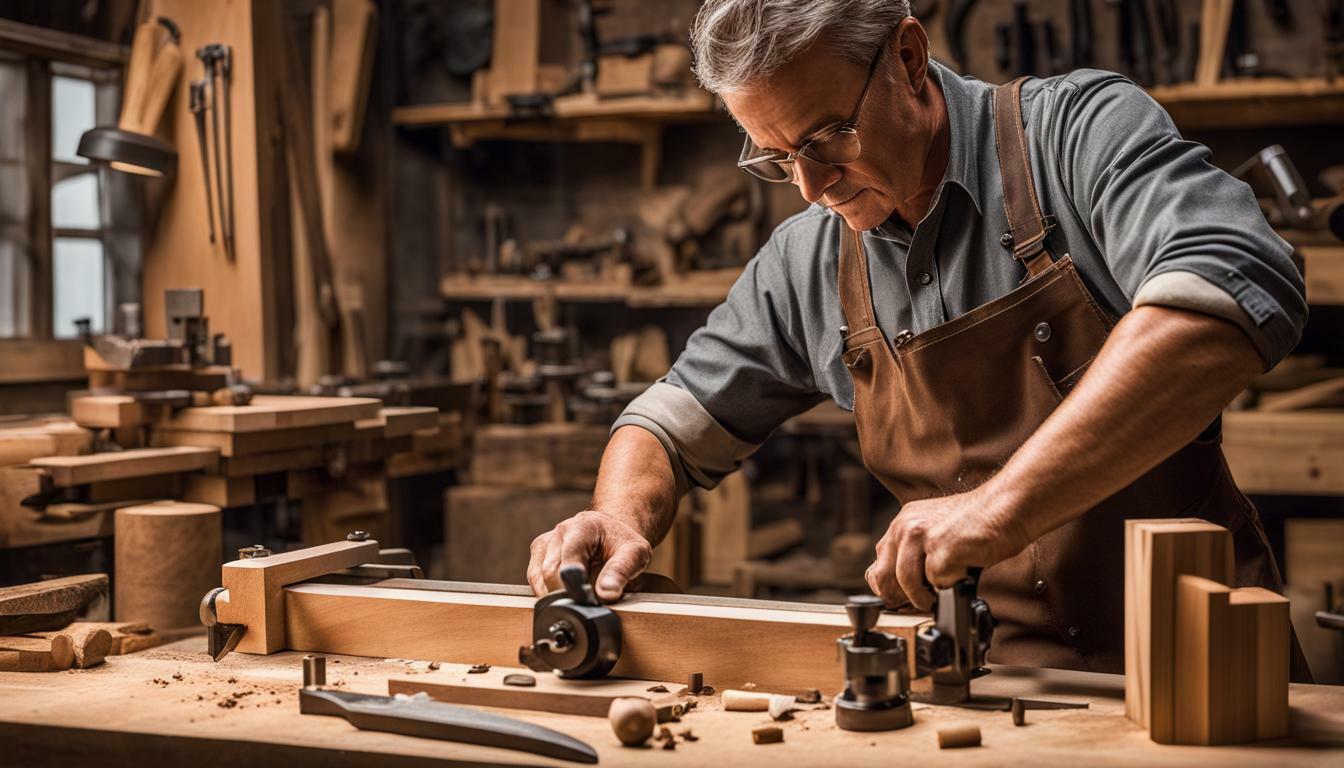
Sharpening your lathe tools is a crucial step in achieving precision and accuracy in your woodworking projects. Dull tools can leave rough and uneven surfaces, making it difficult to achieve the desired results. In this article, we will provide a comprehensive guide on how to sharpen lathe tools efficiently, covering various techniques and tips for achieving optimal results.
Key Takeaways
- Sharpening lathe tools is essential for achieving precise and accurate cuts in woodworking projects.
- Having the right tools, techniques, and abrasives is crucial for efficient lathe tool sharpening.
- Properly sharpened lathe tools can improve the quality of woodworking projects and reduce the risk of accidents.
Understanding Lathe Tool Sharpening Techniques
Sharpening lathe tools is a crucial part of woodworking, and there are various techniques to master. The best way to sharpen lathe tools depends on the type of tool and the wood being worked on. However, sharpening lathe tools doesn’t have to be complex or difficult, and there are easy lathe tool sharpening methods that anyone can learn. In this section, we’ll explore the most effective and straightforward techniques for sharpening lathe tools.
The Grinding Method
Grinding is the traditional method for sharpening lathe tools and is still one of the most effective techniques. To sharpen lathe tools using grinding, you’ll need a bench grinder, a special grinding wheel, and a jig for holding the tool at the correct angle. The process is relatively simple and involves setting the angle of the jig, turning on the grinder, and gently grinding the tool against the rotating wheel. This lathe tool sharpening technique is ideal for removing larger damages, reshaping dull edges, and improving overall cutting performance.
The Honing Method
Honing is the process of using sharpening stones to create a finer edge on the lathe tool. Honing is an essential part of sharpening lathe tools as it removes the burr created by the grinding process and polishes the edge for optimal cutting performance. Honing requires a set of sharpening stones, honing oil, and a jig for holding the tool at the correct angle. The process involves applying oil to the stone, setting the angle of the jig, and gently honing the tool against the stone until a polished edge is achieved.
The Sharpening Jig Method
A sharpening jig is an excellent tool for achieving consistent results when sharpening lathe tools. A sharpening jig is designed to hold the tool at the correct angle, allowing for precise and accurate sharpening. Using a sharpening jig requires a bench grinder or honing stone and involves clamping the tool securely in the jig before grinding or honing. The sharpening jig method is ideal for those new to lathe tool sharpening and ensures a consistent and accurate edge on each tool.
By understanding these lathe tool sharpening techniques and practicing them regularly, you can achieve optimal results with your woodworking. The best lathe tool sharpening method depends on your skill level, the type of tool, and the specific task at hand. However, by following the tips and techniques outlined in this guide, you’ll be well on your way to sharpening lathe tools quickly and easily.
Tips for Precise Woodworking with Sharpened Lathe Tools
Sharpening lathe tools is critical to achieving precise woodworking results. In this section, we will provide guidance on tool positioning, cutting techniques, and maintaining sharp edges during the woodworking process.
Tool Positioning
When using lathe tools, it is essential to position them correctly to achieve precise cuts. Start by placing the tool’s bevel against the wood and letting its cutting edge make contact. Once in contact, you can adjust the tool’s angle to achieve the desired cut.
It is best to keep the tool’s handle close to your body and avoid overreaching to prevent muscle strains and fatigue. Moreover, it is crucial to maintain a steady grip on the tool to prevent it from slipping or bouncing during the cutting process.
Cutting Techniques
Sharpened lathe tools enable precise and clean cuts, and it is crucial to use them correctly. To achieve precise cuts, start by making light cuts and gradually increasing the depth as needed. Take care not to force the tool into the wood, as this can cause it to dig in, leading to inaccurate cuts.
It is also essential to move the tool smoothly and continuously, avoiding jerky movements that can mar the wood surface. It is best to move the tool at a comfortable speed that allows you to control it easily and achieve the desired cut.
Maintaining Sharp Edges
Regularly maintaining the sharpened edges of your lathe tools is crucial to achieving precise cuts. Monitor your tools’ cutting edges to ensure they remain sharp, and sharpen them as needed to maintain their effectiveness.
Avoid touching the cutting edge with your bare hands to prevent oil and moisture from your skin from transferring to the metal, causing rusting and corrosion. Store your tools in a dry, clean place to prevent rusting and damage.
Overall, sharpening lathe tools and using them correctly is essential for achieving precise woodworking results. Follow these tips and techniques as a professional lathe tool sharpening guide to ensure your lathe tools remain sharp and effective.
Selecting the Right Grinding Wheels and Abrasives
Choosing the appropriate grinding wheels and abrasives is a critical step in sharpening lathe tools. Different materials require specific types of wheels to achieve optimal results. For example, diamond wheels are ideal for sharpening tungsten carbide tools, while aluminum oxide wheels are suitable for high-speed steel tools.
When selecting a grinding wheel, consider its grain size and bond type. The grain size affects the wheel’s cutting ability, with larger grains offering faster cutting rates but coarser finishes. Bond type pertains to the material holding the abrasive grains together, affecting the wheel’s hardness and durability. A harder bond is suitable for grinding soft materials, while a softer bond is ideal for harder materials.
It is crucial to maintain the grinding wheel’s condition to ensure precision and efficiency in lathe tool sharpening. Dressing the wheel is vital to remove debris and shape it for optimal sharpening. Keep the wheel clean and dry to prevent premature wear and tear. Regularly check the wheel for cracks and replace it immediately if any are found.
Additionally, always wear appropriate safety gear when handling grinding wheels and abrasives. This includes safety glasses, ear protection, and a dust mask to reduce the risk of injury and exposure to chemicals and debris.
Conclusion
Sharpening lathe tools efficiently is a crucial aspect of achieving outstanding woodworking results. It not only leads to a smooth and precise cutting experience but also increases the lifespan of your tools. So, make sure to follow the techniques discussed in this article to achieve optimal results.
Invest in the Right Tools
Investing in the right tools for the sharpening process is essential for achieving optimal results. A honing guide, grinding jig, and a variety of sharpening stones are must-haves for any woodworker. Don’t forget to maintain your tools regularly to ensure they last a lifetime.
Stay Precise
During the woodworking process, make sure to maintain sharp edges on your lathe tools. Always position them correctly and use the right technique for cutting. Precision is key to achieving perfect woodworking results.
Choose the Right Grinding Wheels and Abrasives
Choosing the right grinding wheels and abrasives is crucial for effective lathe tool sharpening. Consider the material of your tools and pick the right wheels for the job. Don’t forget to maintain your wheels regularly to avoid damaging your tools.
By following the techniques and tips discussed in this article, you’ll be well on your way to sharpening your lathe tools efficiently and achieving excellent woodworking results. Happy woodworking!
FAQ
Q: What are the benefits of sharpening lathe tools efficiently?
A: Sharpening lathe tools efficiently improves cutting performance, reduces the risk of accidents, and enhances the overall woodworking experience. It allows for precise shaping and smoother finishing of woodwork.
Q: What are the essential tools required for sharpening lathe tools?
A: The essential tools required for sharpening lathe tools include a bench grinder, sharpening jigs, honing guides, various grits of grinding wheels, and abrasives. Safety equipment such as goggles and gloves should also be used.
Q: What are the different techniques used to sharpen lathe tools?
A: There are different techniques used to sharpen lathe tools, including grinding, honing, and using sharpening jigs. Grinding involves shaping the tool’s bevel using a bench grinder. Honing focuses on refining the edge using sharpening stones or honing guides. Sharpening jigs provide a guided system for consistent results.
Q: How can I achieve precise woodworking with sharpened lathe tools?
A: To achieve precise woodworking with sharpened lathe tools, it is important to pay attention to tool positioning, maintain a consistent cutting technique, and ensure sharp edges on the tools. Regularly inspecting and maintaining the sharpness of the tools is also crucial.
Q: How do I choose the right grinding wheels and abrasives for lathe tool sharpening?
A: When choosing grinding wheels and abrasives for lathe tool sharpening, consider the material of the tool and the desired outcome. Harder wheels are suitable for high-speed steels, while softer wheels work well with carbon steel. It is important to select the appropriate grit and ensure the wheels are properly maintained.
- Delta Midi Lathe 46-250 Performance - August 27, 2023
- Understanding the Different Parts of a Lathe Machine - August 27, 2023
- Explore Different Lathe Tool Holder Types for Your Projects - August 27, 2023
